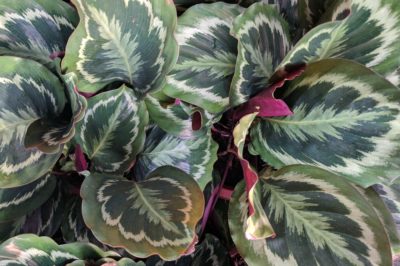If the Pattern in the Leaves Fades or Disappears . . .
As with all plants, chlorophyll turns plant leaves green, and, just as with the leaves on deciduous trees, when Calathea leaves receive full sunlight, the chlorophyll takes over and the striking dark and light patterns on the leaves fade and disappear.
To restore the pattern, simply move your Calathea to a location where it receives more shade or less direct light. The amount of chlorophyll in the leaves will be reduced, and the lighter areas of the leaves that create the patterns will become visible again.
If the Lower Leaves Turn Yellow and Other Leaves Become Spotted or Curl . . .
When the lower leaves of your Calathea begin to turn yellow and/or other leaves begin to curl or develop spots, it’s a sign that the plant is receiving too little water. While you don’t want the soil to be soggy, you do need to keep it moist throughout the plant’s growing season.
Calathea can endure short periods of underwatering if it must, but if that period extends too long, the plant will let you know about it with the aforementioned reminders of your neglect.
If Your Calathea Isn’t Growing Well or the Leave Edges Turn Brown and Brittle
When your Calathea just isn’t growing well in general or if the edges of the leaves begin turning brown and become brittle, it’s usually a sign that the air in the room where you have placed your plant is too dry. Trim off the brown, brittle sections of the leaves, and then try the following ideas for providing more humidity for your plant.
- Move the plant to a room with more humidity, such as the bathroom, laundry room, or kitchen, and then bring the plant out into less humid areas when you want it on display while you are entertaining guests. Return it to its more humid home when the party’s over.
- If you want to leave the plant where it is, misting the leaves will help.
- While, again, you don’t want the soil to be soggy, you can create a pebble tray by placing gravel or pebbles in a pot saucer, placing water in the saucer, and then sitting the pot that contains your Calathea on the pebbles or gravel. As the water in the saucer evaporates, it increases the humidity in the immediate vicinity of the plant.
Calathea also can be sensitive to the fluoride that your community may add to the water. Try watering your Calathea with rain water or distilled water.
If the Leaves Begin to Droop or the Stems Become Limp and Begin to Rot
Drooping leaves and limp or rotting stems can result from one of three problems. Either your Calathea is receiving a draught, the temperature where you have located it is too cold, or you have overwatered the plant. Calathea doesn’t respond well to sudden changes in temperature or to temperatures below 55°F (12°C). Move your Calathea to a warmer location out of any draughts from doors or windows and away from registers and other sources of sudden temperature changes.
If you have been overwatering your Calathea, begin checking the top inch of soil in the pot, and don’t water until that top layer of soil dries out.
If You See Gray Mold Growing on the Leaves or Stems
Because Calathea loves warm temperatures and high humidity, the plant can be susceptible to Botrytus or gray mold. If the air in the room is extremely muggy, you can take steps to lower the humidity somewhat.
The other alternative is to improve the ventilation in the area where you’ve located your plant, but then you also have to avoid putting your Calathea in a draught. Hey, Calathea has a reputation for being difficult to raise, but aren’t those beautiful leaves worthy of the challenges?
